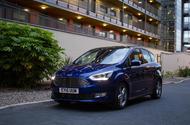
The Ford C-Max is as much fun to drive as it is easy to live with, with plenty of credibility in the used market
The MPV is back – at least on the used car market – with the Ford C-Max.At the beginning of this year, when market prices were high across the board, the trade has been reporting particularly healthy demand and strong prices for MPVs just like it.Here, we cover two generations of Ford C-Max: the second-generation five-seater and its stretched, seven-seat relative, the Grand C-Max, both launched in 2010 and facelifted in 2015.They were based on the then-current third-generation Ford Focus so are good to drive. In fact, this magazine declared the C-Max the class leader for driver involvement. The Grand C-Max attracted almost equal praise, the difference being its more relaxed ride.Petrol or diesel, there are plenty of engines to choose from. Among the petrols, we like the 123bhp 1.0 Ecoboost, although note that some have had issues and the 148bhp 1.5 Ecoboost.Both are smooth, gutsy and reasonably economical but the 1.0 wasn’t introduced until 2012 and the 1.5 until 2015. The 1.6 Ecoboost that was available from launch to 2015 is a sweet-running unit. The diesels – a choice of 1.5, 1.6 and 2.0 engines – are torquey and economical.The 117bhp 1.5 TDCi, which replaced the 1.6 TDCi in 2015, is fine in the C-Max, but the extra pulling power of the 148bhp 2.0 TDCi, also offered from 2015, is welcome in the Grand C-Max.The C-Max has conventional doors, while the Grand C-Max’s rear pair slide to aid passenger access.The C-Max makes up for its lower seat count with a centre rear seat that can be folded away to create a more spacious rear cabin for two. All three seats can be dropped down to give 1684 litres of load space.In the Grand C-Max, folding the centre seat creates a convenient walk-through to the rearmost pair, which are just comfortable enough for children. All of them can be folded flat to provide 1742 litres of load space.MPVs lead a hard life, but the interiors of both C-Max models are reasonably robust. The dashboard has too many buttons and a fiddly touchscreen but gained improved materials and a cleaner design with the 2015 facelift.In fact, the facelift brought improvements across the board: sleeker exterior looks incorporating Ford’s new grille design, improved engines and better kit, including Ford’s Sync 2 voice-activated connectivity system. Improved Active City Stop, the option of parking assistance and a hands-free tailgate all made their way onto the spec sheet.On both cars, the trim levels are Zetec (16in alloy wheels, Quickclear heated windscreen and air-con), Titanium (17in alloys, dual-zone climate control and keyless entry) and Titanium X (part-leather seats and a panoramic sunroof).The Grand C-Max’s seven seats and sliding rear doors shout MPV and, if you have need of them, choosing it over the C-Max is a no-brainer. It’s still smaller than the Galaxy or S-Max, though, so try one of those for size before committing.Think of the five-seat C-Max as a roomier and more practical Focus with a better view out and it too makes a compelling case for itself, as MPVs tend to.Ford C-Max 2010-2019 common problemsEngine: On the 1.0-litre and 1.6-litre Ecoboost engines, check for coolant leaks and, by referring to workshop invoices, ensure the engine oil is the correct grade. Then check with Ford if it has been the subject of a dealer replacement or upgrade. As for diesels, the 1.6 TDCi suffers injector problems and all of them are prone to diesel particulate filter blockages. Gearbox: The Powershift automatic transmission requires a new filter and fluid every three years. Manual cars appear to have suffered a disproportionate number of clutch failures, some caused by a sticking clutch slave cylinder. Steering and suspension: Some owners have reported issues with the electric power-steering system, so be alert to warning lights, heavier steering and even a burning smell. Healthy suspension is key to the car feeling poised and fun to drive. If it feels loose and flabby, a fresh MOT will pick up issues with dampers, springs and bushes. Brakes: This is a family workhorse, so don’t be surprised by deeply lipped front discs, paper-thin pads and zero evidence of biennial brake-fluid changes. Body: Minor dings and dents are inevitable but easily sorted by smart repairers. Still worth haggling over, though. Interior: Water can get in via the mirrors, causing short circuits and the rear doors to refuse to lock. Check the front carpets for damp caused by leaks from the air-con system.
Source: Autocar